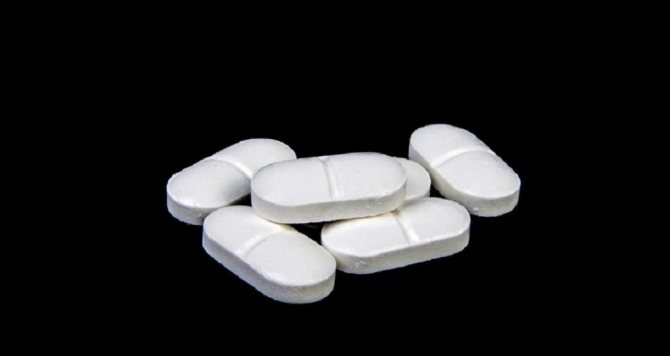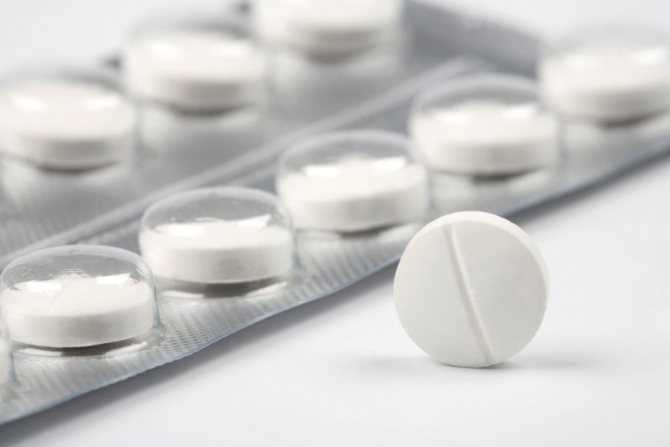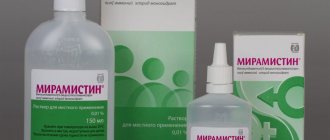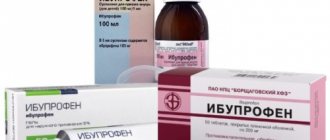Is Paracetamol allowed for nursing mothers?
Paracetamol is the most common drug taken for colds.
But there is another situation that every nursing mother may face. Such a situation is lactostasis - stagnation of milk in the ducts of the mammary gland. Most often, lactostasis is observed in primiparous women, as well as when the baby is not applied correctly to the breast and the baby’s sucking process is ineffective. A woman experiences engorgement of the mammary gland, more often, on the one hand, an increase in temperature to high numbers.
In such cases, paracetamol is allowed during lactation, but must be taken with the permission of a doctor, and you must also follow some rules for taking the drug. Paracetamol for breastfeeding (breastfeeding) is taken at a temperature above 38.5 degrees, keeping an interval between doses of at least 4 hours. Also, the number of tablets per day should not exceed 4.
Overdose
An overdose can develop in a patient only if the permissible dosage is exceeded. So, from thirty tablets a day, the patient will experience irreversible liver damage, and when taking 40 tablets, death is possible. Therefore, you need to carefully monitor the dosage of the drug and do not forget that this substance is contained in many medications.
Paracetamol during breastfeeding is an effective remedy for fever and treatment of various types of pain syndromes. However, despite the relative safety of the drug, a nursing mother should always consult a doctor before taking the drug.
What effects does Paracetamol have?
Paracetamol is widely used in medical practice. The main one is the antipyretic effect. Paracetamol is approved for use by persons with fever of all ages. Also used to reduce fever is the drug Ibuprofen, which is most effective during fever, having an analgesic and anti-inflammatory effect.
Some experts recommend alternating these drugs throughout the day for the best effect, but studies have shown that there is no difference between the combined use of drugs and taking them separately.
A single dosage for paracetamol is 10 - 15 mg/kg, for ibuprofen 6 - 10 mg/kg. Recommendations that if after the first dose of an antipyretic drug there is no improvement in the condition, then the next dose should be given, are fundamentally incorrect.
A decrease in temperature can be observed after 2 doses, but only in the first 3 to 4 hours. This treatment does not affect the temperature in the future. It is also important to observe a single dosage, since increasing it can negatively affect health.
Paracetamol has a slight analgesic effect, but this drug is effective only for mild to moderate pain. People with osteoarthritis can take paracetamol to relieve pain. But today there are the most effective principles of therapy for this disease. Paracetamol can relieve mild pain in osteoarthritis, but has no effect on inflammation, swelling, redness and other symptoms of the disease.
This drug in combination with caffeine is used for headaches and migraines. The combination of paracetamol with nonsteroidal anti-inflammatory drugs may be effective in relieving postoperative pain.
Patent ductus arteriosus is a pathology that often occurs in newborns. The ductus arteriosus should close by the time the baby is born, but if this does not happen, paracetamol can be used in treatment. Nonsteroidal anti-inflammatory drugs are also used, but paracetamol has fewer side effects.
Paracetamol is an excellent alternative as an antipyretic and analgesic in cases where NSAIDs (non-steroidal anti-inflammatory drugs) are contraindicated for one reason or another.
Is it possible to take Paracetamol during lactation, the effect on the child
The instructions for Paracetamol indicate that the drug should be taken with caution during breastfeeding. Meanwhile, most experts in the world recommend this medicine as the first choice for headaches, joint pain, and fever in a nursing mother. A popular website on the safety of medications during breastfeeding indicates that there is no risk of decreased lactation and no negative impact on the child. According to various sources, the amount of medicine that can enter the baby’s body through mother’s milk does not exceed one percent of the volume of the drug taken, which is significantly less than the usual pediatric dose. The WHO and the American Academy of Pediatrics also indicate compatibility with lactation. Despite the safety of the drug, a nursing mother should coordinate its use with her doctor. The latter will take into account the individual characteristics of the woman and child.
In what cases is Paracetamol indicated during breastfeeding?
Paracetamol during breastfeeding can be used for the same indications as mentioned above. Chronic diseases, which involve a course of taking this drug, should be discussed directly with a doctor. And only a specialist can select the right treatment, which should not negatively affect the child and will benefit the mother.
Short-term use of paracetamol for infectious diseases and lactostasis in the mother does not affect the growth and development of the child. Paracetamol during breastfeeding for headaches can take place as a temporary treatment measure.
Description and properties of the drug
The medicine is a non-steroidal analgesic that is used to treat adults and children. It is also possible for infants to take paracetamol, but in this case the dosage is determined by the pediatrician regarding the weight and age of the child.
Paracetamol is used to relieve headaches, toothaches and reduce fever, including during breastfeeding. Syrups and suspensions are used to treat children over one year of age, tablets and capsules are used for adult patients, and suppositories with paracetamol are used for infants. Is it possible to give paracetamol tablets to a baby? It is possible, but in this case you should carefully follow the dosage indicated by the doctor, otherwise the risk of overdose increases.
The main advantage of the drug is the fact that it is less toxic compared to other medications in this group. For example, it is safer than analgin. In addition, its antipyretic properties are quite strong, and at the same time reduce body temperature to normal levels, which is a big plus compared to aspirin, which reduces fever to a temperature of less than 36 degrees.
Rules for using Paracetamol during breastfeeding
The most popular antipyretic during breastfeeding is the drug Paracetamol.
Paracetamol during lactation is prescribed at temperatures above 38.5 degrees. Taking this drug must comply with the general rules of use.
- 1 paracetamol tablet - 500 mg is a single dosage for a nursing woman.
- It is recommended to take the medicine after feeding so that the concentration of paracetamol in breast milk is minimal.
- It is important to maintain an interval between doses of the drug of at least 4 hours.
- You should also take no more than 4 tablets per day.
- The course of taking paracetamol should not exceed 3 days.
Often, the temperature in infectious diseases and lactostasis normalizes over a given period of time. If a nursing mother has been bothered by a fever for a long time, it is recommended to immediately consult a doctor.

Photo: https://pixabay.com/photos/thermometer-headache-pain-pills-1539191/
Directions for use and doses
How much paracetamol can you take while breastfeeding? In this case, specialists prescribe a standard dosage for an adult, five hundred milligrams at a time. How many times a day can nursing mothers take paracetamol? The permissible dosage per day is four tablets. In addition, the use of medication is not a compelling argument for replacing breast milk with formula.
The medication in tablets begins to act forty minutes after use and its effect lasts about six hours. Within an hour after use, the concentration of the drug reaches its maximum and gradually begins to decrease. This means that in such a period of time it is possible to minimize the effect of paracetamol on the infant.
To do this, you need to feed the child before taking the medicine and not feed it for two hours after taking the medicine. How long does it take for paracetamol to be excreted from breast milk? This medication is completely eliminated from the body six hours after use.
Is it possible to use paracetamol suppositories rather than tablets when breastfeeding? Each mother can choose the optimal form of release of the medicine. Candles are less harmful, but also less effective. Their action begins fifteen minutes after administration and the effect is much less. That is why paracetamol suppositories are used preferably for infants, the effectiveness of which is sufficient for infants.
Contraindications for the use of Paracetamol for hepatitis B
Breastfeeding is not a contraindication for the use of paracetamol. Also, during an illness, you should not switch your child to formula. It is not even recommended to start artificial feeding while taking paracetamol.
Contraindications for the use of this drug include an allergic predisposition or intolerance to the components of the drug, severe impairment of liver and kidney function (Paracetamol has some hepato- and nephrotoxic effects), decreased hemoglobin concentration (anemia).
What other than paracetamol?
In addition to paracetamol, in order to achieve an antipyretic effect during breastfeeding, you can use a drug from the group of non-steroidal anti-inflammatory drugs - Ibuprofen.
Safe antipyretics for a breastfeeding baby are Ibuprofen and Paracetamol.
The concentration of Ibuprofen in breast milk is small and does not affect the growth and development of the baby. It is recommended to take the drug immediately after feeding with water. Taking medications after feeding reduces the concentration of the drug in breast milk.
There are also rules for Ibuprofen. The maximum daily dosage for the drug should not exceed more than 4 tablets or capsules. It is important to maintain an interval of at least 4 hours. The course of treatment should be short-term.
Can I take Paracetamol while breastfeeding?

Many studies have shown that Paracetamol and breastfeeding can be combined [3]. It is approved for nursing mothers and children over 3 months of age. Before taking the drug, consult your doctor about the dosage.
The drug passes into breast milk in an amount of 0.04% to 0.23% of the dose taken by the mother.
Monitor your baby's reaction; sometimes allergies are possible - hives, itching, skin rash. In rare cases, regurgitation, rumbling in the stomach and diarrhea may occur. Do not worry, adverse reactions when taking Paracetamol are very rare. In most cases, this is due to an overdose of the drug and non-compliance with the instructions.
How long does it take for Paracetamol to be excreted from breast milk?
The maximum concentration of the drug in breast milk is achieved after 0.5-2 hours. Paracetamol is excreted from breast milk within 1-4 hours.
Despite the safety of the medicine, you need to weigh the expected benefits of treatment for the mother and the possible risks for the baby. The possibility of using Paracetamol by a nursing mother is decided in each specific case by the attending physician.
9 rules of admission for a nursing mother
Compliance with the recommendations for the use of Paracetamol allows you to achieve the maximum effect of the drug and avoid adverse reactions. It is important for a nursing mother to adhere to the following rules:
- Dosage – 500 mg no more than 4 times a day.
- The maximum duration of treatment is 3 days.
- The baby should be fed breast milk before taking the medicine.
- Before the next feeding, at least two hours should pass, preferably four.
- You should not take more than 1 g (2 tablets) at a time, or more than 4 g per day.
- The minimum effective dose should be used. Perhaps a woman needs just one tablet a day to get the effect.
- Take the tablets with boiled water, without using coffee or tea.
- Do not take Paracetamol during breastfeeding at the same time as ibuprofen and other analgesics.
- Naturally, no alcohol.
Interaction with other drugs
The compatibility of Paracetamol with other drugs is the subject of many studies:
- Use with activated carbon: the amount of Paracetamol entering the blood is reduced.
- With contraceptives: the analgesic effect of Paracetamol is reduced and its removal from the body is accelerated.
- When used simultaneously with Diazepam: the elimination of Diazepam from the body is slowed down.
- Combination with Isoniazid: the toxic effect of Paracetamol increases.
- With Metoclopramide: the absorption of Paracetamol increases, its concentration in the blood increases.
What should you not combine paracetamol with?

Some women who are breastfeeding may take any medications for a long time. Chronic diseases require constant medication. The use of such drugs may coincide with the use of Paracetamol. But the latter cannot be combined with certain medications that you need to know about. Inducers of microsomal liver enzymes (Phenobarbital) are not recommended to be taken together with Paracetamol.
Both drugs have a hepatotoxic effect, but individual drugs may not exhibit this negative effect. But as soon as the combined use of these medications is observed, the adverse effect on the liver intensifies.
Drugs from the group of anticoagulants (Heparin, Warfarin) together with Paracetamol can change blood parameters that affect coagulation.
An antipyretic may not have the desired effect on fever due to poor absorption. The drug is characterized by a lack of absorption when used with anticholinergics (Atropine, Ipratropium bromide) or with activated carbon.
Paracetamol can also reduce the antipyretic and analgesic effect due to the fact that it is quickly eliminated from the body. This situation occurs when taken together with oral contraceptives. If the temperature rises, the doctor must tell the doctor about her chronic diseases, as well as about the medications that the woman is currently taking. Some drug combinations do not produce the desired effect or may even be harmful to both the nursing mother and the baby.
pharmachologic effect
This drug is the safest drug from its group, since it does not have a harmful effect on the gastrointestinal tract and practically does not accumulate in breast milk. The essence of its therapeutic effects lies in its impact on thermoregulation centers, resulting in an increase in the pain threshold.
The drug has a pronounced analgesic and antipyretic effect with a weak anti-inflammatory effect. It absorbs well and is completely excreted from the body by the kidneys.
Possible side effects and overdose
Side effects are detected quite rarely. From the gastrointestinal tract, nausea, vomiting, and abdominal pain may occur. Long-term use of Paracetamol provokes the development of a hepatotoxic effect. In this regard, there is a decrease in liver function.
If the patient had an allergic predisposition to this drug, then a rash, redness, swelling, and itching may be observed on the skin. A long course of Paracetamol impairs kidney function. Long-term use of this drug can affect blood cells, reducing their concentration, in particular hemoglobin, red blood cells, and platelets.
An overdose is very dangerous for the liver. Improper use of Paracetamol leads to necrosis of liver cells and tissues. The degree of damage to this organ depends on the duration of use of the drug and the dose.
The patient also experiences nausea, vomiting, and lack of appetite. If these symptoms appear, you should immediately consult a doctor. Treatment of overdose involves performing a gastric lavage procedure, a cleansing enema and taking activated charcoal.
How to help yourself with a cold. Advice for nursing mothers

Photo: https://pixabay.com/photos/lactation-chest-baby-breastfeeding-3508242/ The main question that worries mothers when acute respiratory diseases occur is: is it possible to breastfeed? The answer is yes, you can, but you must use the drug following certain rules.
Physical cooling methods
Physical cooling methods can be used to reduce the temperature. But you should forget about wiping with vodka or vinegar! These methods are dangerous and poorly effective. The temperature of the skin drops during such rubbing, but the internal organs retain their original temperature or even increase.
A safe physical method is to cool by wiping the forehead with a wet towel at room temperature. This method also reduces headaches.
Nasal rinsing
With acute respiratory infections, patients are often bothered by nasal congestion. This symptom can be combated by frequently rinsing the nasal passages with saline or sea salt solution (Aqualor, Aquamaris). This procedure can be repeated every 3 to 4 hours, depending on the patient’s condition.
The use of vasoconstrictor drops is not recommended because they are addictive and their effect is short-lived. Irrigation with sea water can also relieve swelling of the nasal mucosa and facilitate nasal breathing. Also, with ARVI, patients often experience a sore throat.
Mouth rinse
To relieve discomfort, it is recommended to rinse the mouth with antiseptic solutions (Chlorhexidine, Miramistin) or herbal solutions (Chamomile, Sage). You should rinse regularly and with greater frequency for faster recovery.
To relieve a sore throat, there is a drug called Lizobact, which is approved for pregnant and nursing mothers. During illness, patients should drink more fluids to quickly remove toxins from the body.
Call a doctor
If a nursing mother's temperature rises to high levels, then you should immediately call a doctor. Only a doctor can make the correct diagnosis. Breastfeeding mothers may face more serious illnesses. For example, sore throat, pneumonia or kidney inflammation. Only a thorough examination will help determine the cause of the fever. The patient may also need to prescribe additional research methods.
For pneumonia - chest x-ray. After this procedure, it is not necessary to express milk, because X-ray radiation does not penetrate into breast milk and cannot affect the baby. For pyelonephritis, a general urine test and ultrasound examination of the urinary system are necessary.
These diseases require immediate antibiotic therapy. But even antibiotics are not a reason to switch to artificial feeding. Antibacterial drugs, in particular Flemoxin, which can be prescribed for pyelonephritis, sore throat or pneumonia, can be used in nursing women and are safe for the child.
Rules for taking medication for nursing mothers
Paracetamol can be used by women during lactation only as prescribed by a doctor. The main directions of the drug are pain relief and reduction of the inflammatory process in the body. When taking medication, the following recommendations should be followed:
- Heat. If a breastfeeding mother’s body temperature is below 38 degrees, then there is no need to take antipyretic medications. An increase in temperature to the above values means that the body has begun an active fight against the infection, and excess medications can only hinder this process. If a nursing mother’s body temperature rises above 38 degrees, then she can take paracetamol in the recommended dosage.
- Tooth, joint or headache. If periodic minor painful sensations occur, breastfeeding women do not need to take painkillers. It is important to know that medicinal substances pass into breast milk, and this can negatively affect the health of the newborn. The best way to get rid of aching and minor pain is a walk in the fresh air. If the pain manifests itself sharply, then it cannot be tolerated (especially during lactation). It is in this case that the use of a drug with an analgesic effect is recommended.

Mothers need to take paracetamol only after feeding the baby. The peak of active components in the blood appears 30-40 minutes after therapy with this medicine, and it is during this period of time that it is undesirable to breastfeed the baby. 4 hours after internal use, the medicine is completely eliminated from the body by both the liver and kidneys. After the specified time, you can put the newborn to the breast without any fear.
Treatment of lactostasis
A woman may have lactostasis (milk stagnation), which must be properly treated. Without appropriate therapy, the patient is at risk of developing mastitis. Inflammation and necrosis of breast tissue requires only surgical treatment.
This situation will have an adverse effect on both mother and child. The latter will have to switch to artificial feeding, since the mother will not be able to perform her functions in a hospital setting. Also, during a long break from breastfeeding, milk gradually decreases and the lactation period may stop completely. Lactostasis is manifested by increased temperature and chest pain. The pain syndrome is often unilateral.

Photo: https://www.pexels.com/
With lactostasis, while the baby is feeding, the temperature can decrease without the use of antipyretics.
A nursing woman can independently feel lumps in her breasts. Such formations indicate stagnation of milk in the lobules. The location of the seals indicates how best to position the baby during feeding. It is important to put the baby to the breast as often as possible for better resorption of stagnant formations.
Warm compresses are not recommended during lactostasis because they increase milk flow. You should also avoid hot showers, baths, and hot tea. Drinking plenty of liquid also increases milk volume. Cool compresses should be applied to the affected breast. This procedure relieves swelling and improves the patency of the milk ducts.
During feeding, it is recommended to do a light massage, which also helps eliminate stagnation. Some experts recommend smearing the affected breast with Traumeel ointment. This medicine is homeopathic and is used for various injuries. In the case of lactostasis, it is necessary to relieve swelling.
Milk stagnation most often occurs due to wearing uncomfortable and constricting clothing, and sleeping on the stomach and side can also lead to stagnation. Lactostasis occurs in lobules, the outflow of milk from which is often difficult.
During this period, it is important to constantly offer the affected breast to the baby. And from the other, express milk until a state of relief. The baby's position during feeding should be constantly changed until the woman understands which position reduces the lump. Pressing on the breasts is strictly prohibited, because the milk ducts may be damaged.











